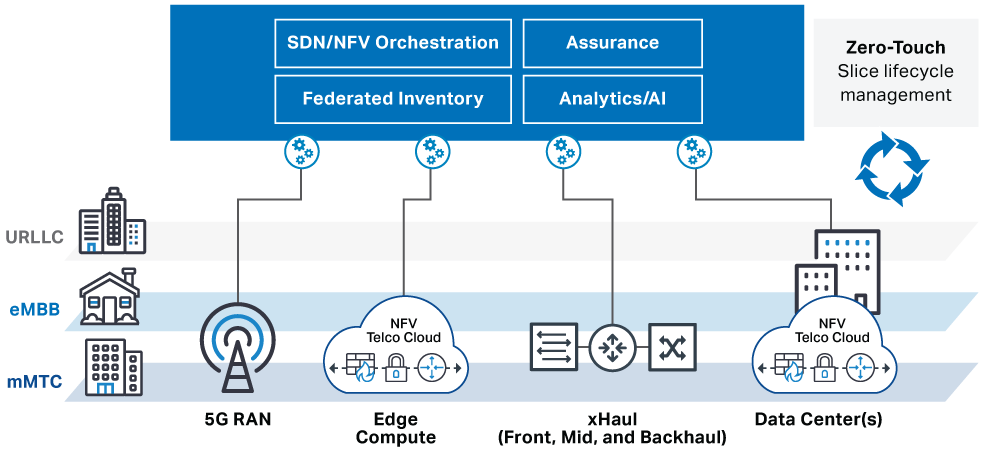5G network slicing: Thinking beyond the RAN
5G network slicing is often discussed in the narrow context of optimizing RAN performance. In this blog, Monica Paolini, Principal at Senza Fili, takes a broader view of network slicing as a way to fundamentally transform how CSPs manage and provision traffic and services end-to-end.
5G network slicing is often presented as a way to optimize RAN performance to support customized network services that enable new and different applications, such as online gaming or enterprise IIoT services (e.g., automated manufacturing or connected vehicles). With network slicing, CSPs can reliably support the low latency, jitter, and high throughput they need to monetize these services.
At the same time, network slicing greatly increases complexity - and it requires a 5G standalone (SA) core, leaving many to wonder if it is worth the effort. After all, not many applications require the virtually separated channel that a slice creates.
And this may very well be the case because this is an argument based on a narrow view of network slicing as a laser-focused solution to address a profitable, and yet circumscribed, market opportunity.
If we take a broader view of network slicing as a way to fundamentally transform how CSPs manage and provision traffic and services end-to-end, the value proposition of network slicing expands from a niche solution to the pinnacle of the digital transformation enabled by 5G.
End-to-end network slicing brings together traffic and service management
If we take a broader view of network slicing as a way to fundamentally transform how CSPs manage and provision traffic and services end-to-end, the value proposition of network slicing expands from a niche solution to the pinnacle of the digital transformation enabled by 5G.
Central to this transformation is a new way to think about traffic and services. In today’s networks, CSPs tend to optimize traffic independently of the services it carries. The assumption is that the better networks perform, the better the services will too. In other words, infrastructure and services coexist in the network but are largely logically separated.
Network slicing culminates a process initiated by 5G that brings traffic and service management and provisioning together – not just in the RAN but across the end-to-end network across physical and virtual network elements. Services determine how to route traffic, and network capabilities define the service features that CSPs can reliably offer. As a result, CSPs can use their network resources more efficiently and extract more revenues.
Bringing together traffic and services requires an approach to network slicing that goes beyond the RAN and covers the entire network, from the 5G RAN to the 5G core, from the edge to the cloud, including transport and data centers. While network slicing is deeply rooted in 3GPP and NGMN standardization efforts, it goes beyond them. CSPs must support network slices through network interfaces and elements outside the 3GPP/NGMN territory. For sure, the RAN still plays a crucial role in network slicing, but RAN slicing alone is not sufficient to ensure the end-to-end service performance consumer and enterprise customers need and are willing to pay a premium for.
The RAN plays a crucial role in network slicing, but RAN slicing alone is not sufficient to ensure the service performance consumer and enterprise customers need and are willing to pay for. It is imperative for CSPs to move to end-to-end network slicing.
Optimization and complexity tradeoffs
Network slicing not only extends to the end-to-end network: it has to cover all traffic to optimize the coexistence of services with radically different requirements. Indeed, it is the variety of requirements that makes network slicing worth the effort. If all traffic required the lowest latency and highest reliability and availability, the value of network slicing would be limited because all slices would have comparable definitions. It is the combination of best-effort and more demanding services that increases the efficient use and monetization of the network.
Going from RAN slicing to end-to-end network slicing increases the complexity of the transformation. Again, we need to ask whether it is worth it. And again, if network slicing is only a way to support some new services, it may not be worth it in the short term, or maybe not even in the long term. Instead, we should look at network slicing as the final phase of a transformation path that CSPs have already embarked on. Eliminating this step would reduce the value of the overall transformation.

A two-pronged strategy for network slicing
However, the increase in network complexity that comes with network slicing creates a challenge. CSPs must assess it realistically and have the necessary resources to address it. The transition to end-to-end traffic and service management and provisioning requires CSPs to get ready for this increased complexity ahead of the commercial deployment of network slicing.
Leading CSPs are using a two-pronged strategy to succeed here. First, they are striving to increase resource manageability, as their networks will have more vendors and technologies to support. Open interfaces and standards-based solutions are crucial to this, as they facilitate scale and help power advanced inventory and orchestration capabilities.
Second, they are introducing automation guided by artificial intelligence (AI), machine learning (ML), and analytics to mask the complexity and to dynamically optimize and assure network performance in real-time with improved granularity.
Beyond the RAN, the path to network slicing may be more challenging but also more rewarding.
